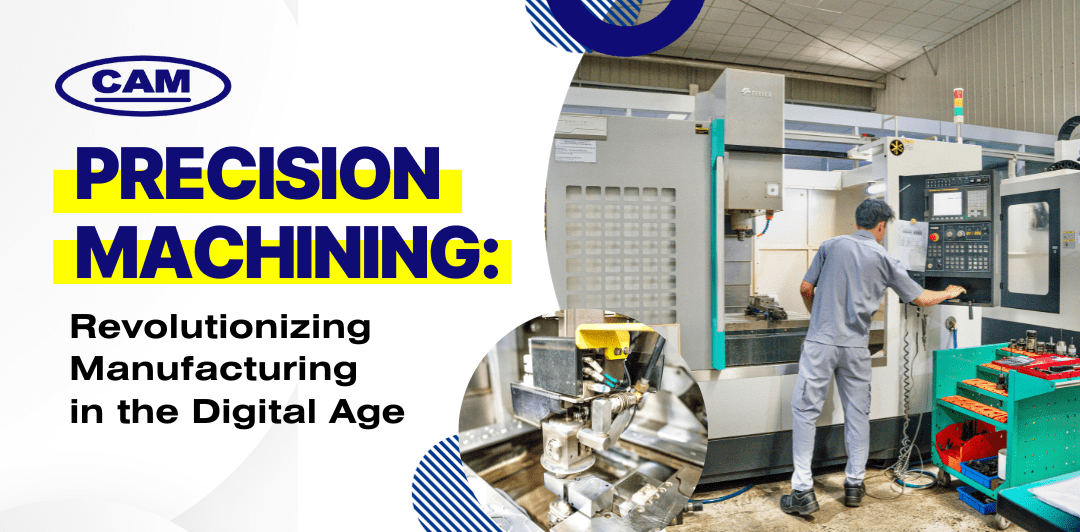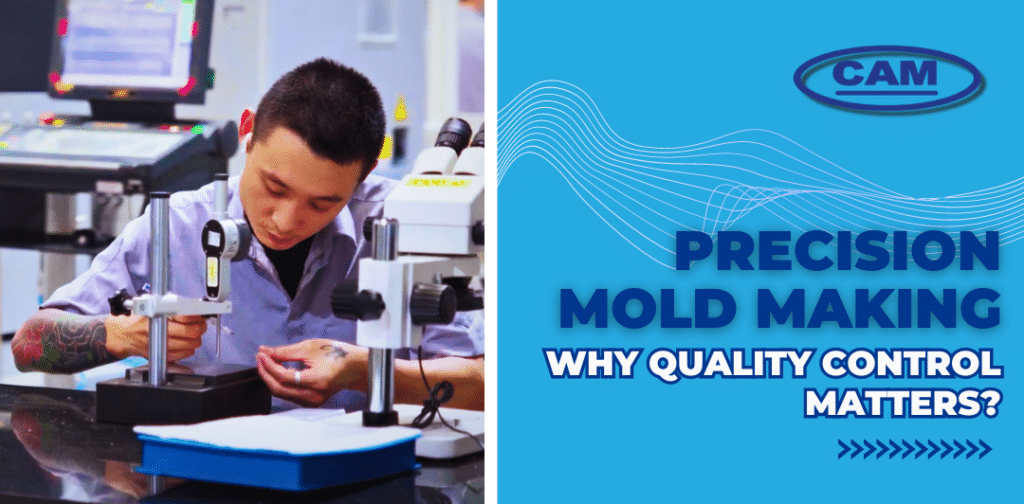Precision machining is extensively used in the tool and die-making industries to produce molds, dies, jigs, and fixtures. But why? Manufacturers rely on high-quality and accurate machine parts that offer repeatability and better performance for the final product. Now, wouldn’t you want to explore further?

The Industrial Revolution marked a significant moment in history when there was a rapid transition from manual labor to machine-based production. Those were the times when manufacturers felt the real need for tools and machines as alternatives for speeding up the process of crafting various devices and instruments.
Precision machining from time to time kept disrupting the pace of manufacturing, whether it be with the inventions of metal cutting lathes in the mid-1500s, turning machines in 1751, milling machines in the 1800s, and EDM and CNC machines in the 1940s. With precision machining, manufacturers were able to produce standardized and interchangeable parts, leading to the development of assembly line production systems.

Precision machining is a manufacturing process that involves the removal of material from a workpiece to create a desired shape and size with a high level of accuracy. It’s highly controlled and utilizes computer-controlled machines, to perform the machining operations to ensure consistent and precise results. Let’s understand precision machining from soup to nuts through this article!
Understanding Precision Machining
Precision machining has become an indispensable part of modern manufacturing. This process involves the removal of material from a raw workpiece to create intricate or complex geometries, typically achieved through the collaboration of skilled designers and engineers and state-of-the-art equipment. The process of precision machining relies on specialized cutting tools that are designed to remove material from the workpiece with extreme precision. Check this article from Goodwin University to have a deeper understanding of how to get involved in precision machining.
There are several types of precision machining processes commonly used in the manufacturing and engineering industries. Some of the most common types of machines include turning, milling, drilling, grinding, laser-cutting, EDM, etc., subject to the requirements of the part being machined. The cutting tools are driven by the machine’s motor, which rotates them at high speeds to efficiently remove the material.

By employing advanced technology and meticulous attention to detail, precision machining enables the creation of high-quality components that are essential for modern manufacturing processes. Let’s get into the details.
The process of Precision Machining
The process of precision machining involves several steps to produce high-quality and accurate parts. Here is a general overview of the process:
Selecting appropriate materials
When it comes to precision machining, selecting the appropriate materials is a crucial step in achieving high-quality results. Different materials have a wide range of properties, such as hardness, ductility, and thermal conductivity, which can affect the machining process and the final product. This information is critical in determining the type of material that will be best suited for the job. For instance, if the part requires high strength and durability, a material with high tensile strength such as stainless steel or titanium may be appropriate.
The next step is to determine the specific machining process that will be used to create the part. Different processes require different materials, so this is an important factor to consider. Once the machining process has been identified, it’s important to consider the properties of different materials. You can also take references about the top 5 commonly used materials in precision tooling.
By carefully considering all of these factors, the appropriate material for precision machining can be selected to ensure that the final product meets the desired specifications.

Designing graphical model
After selecting the appropriate materials to meet the customer needs, it comes to the step of designing a graphical model to display an overview of the target molds. This model serves as a blueprint for the machinist, providing a visual representation of the part and its dimensions.

This is particularly important in precision machining, where even the smallest deviation from the desired dimensions can result in a part that does not function as intended. The model can be created using computer-aided design (CAD) software, which allows the machinist to create a highly accurate and detailed model of the part that can be viewed from different angles.
In addition to its use as a blueprint, the graphical model also serves as an important communication tool between the machinist and other members of the production team to ensure that everyone is on the same page regarding the design and specifications of the part. This can help to prevent errors or misunderstandings that could result in costly mistakes during production.
Setting up the machine
After the blueprint is created using CAD software, it is converted into a format that is compatible with CAM software to facilitate the setup of machines. This enables the blueprint to be fully understood by the machines in the process and that the part will be manufactured to the exact specifications required.
The setup process involves several steps, including aligning the workpiece, selecting the appropriate cutting tools, and setting the cutting parameters such as speed, feed rate, and depth of cut. The machinist must also ensure that the machine is clean and free of debris, as even small particles can cause errors in the machining process.

In addition to ensuring that the machine is set up correctly, the machinist must also monitor the machine throughout the machining process to ensure that it is operating correctly. This involves checking the cutting tools for wear and adjusting the cutting parameters as needed to ensure that the part is being manufactured accurately.
Programming the machine
Once the graphical model has been created and the machine has been set up, the machinist comes to programming the machine to ensure that it cuts the part to the exact specifications required. This involves creating a sequence of commands that tell the machine how to move and cut the part.
The programming process can be done manually or using computer numerical control (CNC) software, which allows for precise and repeatable movements of the machine. Once the program has been created, it is tested to ensure that it produces a part that meets the desired specifications.

Programming the machine accurately is essential in precision machining, where even small deviations from the desired dimensions can result in a part that does not function as intended. By programming the machine carefully and thoroughly testing the program, the machinist can ensure that the final product meets or exceeds customer expectations.
Inspecting the finished product
Once the part has been manufactured, it must be inspected to ensure that it meets the desired specifications and functions as intended. The inspection process typically involves using a variety of QC equipment such as microscopes, hardness testers, and coordinate measuring machines (CMMs) to measure the dimensions of the part and check for any defects or imperfections.

The inspection process must be thorough and accurate, as even small deviations from the desired specifications can result in a part that does not function as intended. The machinist must also ensure that the inspection process is repeatable, meaning that the same measurements can be taken consistently over time. This is important for ensuring that the final product is of high quality and meets or exceeds customer expectations.
If any issues are identified during the inspection process, the machinist must determine the cause of the issue and take corrective action. This may involve making adjustments to the machining process or programming, or it may require starting the process again from the beginning.
What equipment is involved in the Precision Machining process?
So what does precision machining engineering comprise? Precision machining is a versatile process that finds wide applications in various industries. As different parts may require different types of cutting, a range of cutting tools and equipment have been developed to cater to these diverse needs. Let’s run through a few, one by one:
CNC milling machine
CNC milling is a popular machining technique used in precision machining. It involves the use of a computer-controlled milling machine to create complex parts with high accuracy and tight tolerances. The CNC milling machine uses cutting tools that rotate at high speeds to remove material from a workpiece, creating the desired shape and dimensions. They also have a wide range of applications in precision molds and dies manufacturing.
CNC turning machine
CNC turning is another popular machining technique used in precision machining. The CNC turning machine uses cutting tools that move along the surface of a rotating workpiece, removing material to create the desired shape and dimensions. CNC turning machines are capable of creating parts with complex geometries that would be difficult or impossible to create using manual machining techniques.

Surface grinding machine
Surface grinding is a machining process used in precision machining to create smooth and flat surfaces on a workpiece. The machine uses a rotating grinding wheel coated with abrasive particles to remove material from the surface of the workpiece, creating a highly accurate and flat surface

Drill presses
Technicians use drill presses in precision machining to create holes in parts with tight tolerances. They begin by selecting the appropriate drill bit for the desired hole size and material being drilled. The workpiece is then securely clamped to the table of the drill press, ensuring that it is properly aligned and level.
EDM (electrical discharge machining)
EDM is a non-traditional machining process that uses electrical discharges to erode material from the workpiece. The EDM machine consists of a power supply, electrode, and dielectric fluid. The workpiece is submerged in a dielectric fluid, and the electrode is positioned above it. The power supply generates an electrical discharge between the electrode and the workpiece, eroding material from the workpiece to create the desired shape.

Laser cutting machine
Technicians use laser cutting machines (a non-contact cutting process) in precision machining to create highly accurate and precise cuts in a variety of materials. The workpiece is positioned on the laser cutting bed, and the laser beam is directed onto the workpiece, cutting through the material to create the desired shape.
Stay tuned for our upcoming blog on the significance of precision machining and why it’s the only way for manufacturers to achieve ultimate precision.
CAM Resources – Your Trusted Partner for Precision Machining
Precision machining is a critical process that enables the creation of highly accurate and precise parts for a wide range of industries. With its ability to produce parts with tight tolerances, intricate geometries, and complex features, precision machining has revolutionized the manufacturing industry, allowing for faster, more efficient, and more cost-effective production of high-quality parts.

At CAM Resources, we are committed to exceeding your expectations with the highest quality precision machining services available. From design to production, our state-of-the-art equipment and advanced software allow us to produce parts with the highest level of precision and accuracy. Furthermore, our skilled technicians ensure that each part is produced to exact specifications with the tightest possible tolerances. We are dedicated to providing our customers with personalized services that meet their unique needs and requirements, ensuring that they are completely satisfied with the finished product.
Whether you need a single prototype or high-volume production runs, CAM Resources is the precision machining company you are looking for.
Contact us today to learn more about our services and how we can help you achieve your manufacturing goals.
Minh Ngoc Truong
Hi, I'm Minh Ngoc, a dedicated blog writer and social media manager at CAM Resources.

